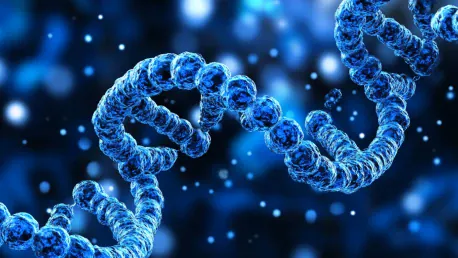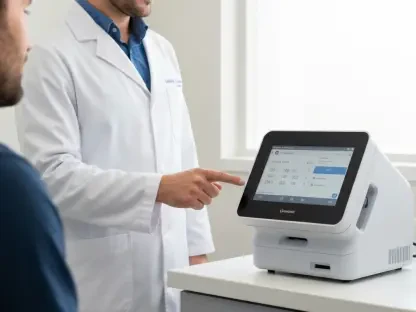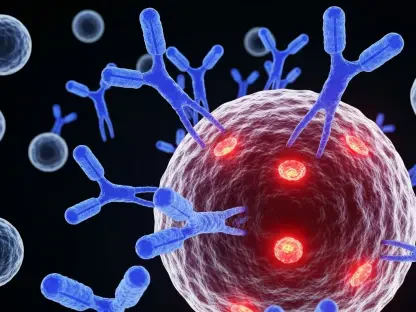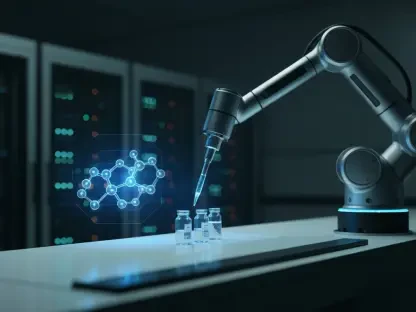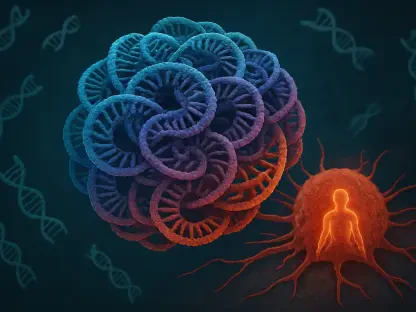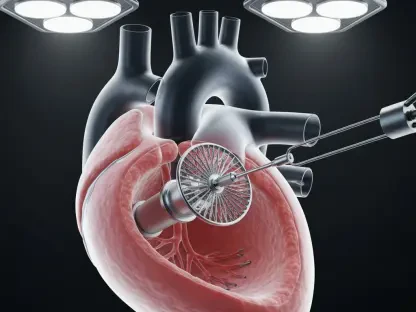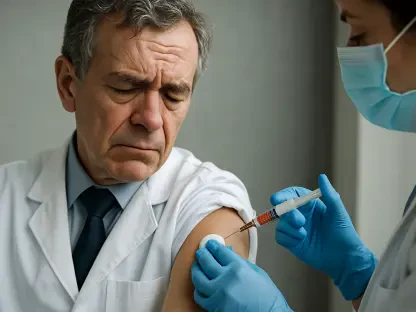Gene therapy, a revolutionary approach to treating and preventing diseases by modifying faulty genes, relies heavily on accurate measurement techniques. Ensuring the safety and efficacy of these treatments necessitates precise quantification of adeno-associated virus (AAV) vectors, which deliver therapeutic genetic material to patients’ cells. A recent study conducted by the National Institute of Standards and Technology (NIST), the National Institute for Innovation in Manufacturing Biopharmaceuticals (NIIMBL), and the U.S. Pharmacopeia (USP), with participation from six industrial laboratories across the United States and Europe, has revealed significant inaccuracies in commonly used gene therapy measurement methods.
Critical Need for Accurate Measurements
Importance of Precision in Gene Therapy
In gene therapy, the accuracy of measuring AAV vectors is crucial. These measurements determine the concentration of genetic material and viral particles, which directly impacts the therapy’s safety, efficiency, and overall effectiveness. Without precise measurements, the risk of administering incorrect dosages increases, potentially leading to ineffective treatments or adverse effects. Ensuring the correct dosage of AAV vectors can mean the difference between a successful outcome or a dangerous complication for patients undergoing gene therapy treatments.
Precision in these measurements also reflects the broader implications for the standardization of gene therapy protocols. Accurate quantification provides a reliable foundation for gauging therapeutic efficacy. If the measurements vary, pharmaceutical companies and healthcare providers face challenges in developing reliable dosing strategies. Various factors, such as vector type, delivery method, and individual patient response, underscore the importance of standardized, repeatable measurement techniques in achieving successful gene therapy outcomes.
Methods Evaluated in the Study
The study evaluated four primary measurement techniques: Polymerase Chain Reaction-Enzyme-Linked Immunosorbent Assay (PCR-ELISA), Size Exclusion Chromatography with Multi-Angle Light Scattering (SEC-MALS), Sedimentation Velocity-Analytical Ultracentrifugation (SV-AUC), and A260/A280 Dual Wavelength Ultraviolet Spectrophotometry. Each method was scrutinized for its accuracy, precision, and reproducibility. These methods were chosen due to their prevalent use in laboratories and their potential for providing critical data needed in the careful quantification of AAV vectors.
Each technique brings a unique approach to measurement, encompassing different strengths and weaknesses. For instance, PCR-ELISA combines the benefits of quantifying genetic material with viral shell protein detection. Meanwhile, SEC-MALS emphasizes the measurement of genetic material concentration, offering potential accuracy advantages. SV-AUC is typically heralded as the gold standard for AAV vector measurements. The often-used A260/A280 UV spectrophotometry is convenient but may fall short in producing highly accurate measurements. Understanding these methods’ variability can guide laboratory practices towards more consistent and accurate gene therapy outcomes.
Findings on PCR-ELISA
Accuracy and Precision Issues
PCR-ELISA emerged as the least accurate and precise method among the four tested. The study found that PCR-ELISA displayed poor reproducibility, meaning its results could not be reliably replicated within the same lab or across different labs. This inconsistency poses a significant challenge for gene therapy applications, where reliable measurements are paramount. The method’s lack of reproducibility could lead to varying therapeutic dosages, risking patient safety and the overall efficacy of gene therapy treatments.
The reliance on both PCR and ELISA techniques in one method inherently introduces a multitude of variables that can be difficult to control uniformly across differing laboratory conditions. When laboratories report varying outcomes using PCR-ELISA, it showcases an underlying flaw in obtaining standardized measurements. The need for harmonized practices is paramount to ensure consistency and reliability across the gene therapy field. This issue highlights the critical gap where PCR-ELISA falls short of the required measurement standards for therapeutic applications.
Challenges and Inconsistencies
Despite combining two established techniques—PCR for quantifying genetic material and ELISA for measuring viral shell proteins—PCR-ELISA faced challenges. Differences in manufacturing and usage led to inconsistent results, akin to following the same recipe but using different equipment or ovens, resulting in varied outcomes. The variability in reagents, equipment calibrations, and user expertise across different laboratories further contributes to the inconsistencies seen with PCR-ELISA measurements.
The study revealed that even minor differences in protocol execution could lead to significantly different results. For instance, variations in PCR thermal cycling parameters or inconsistencies in ELISA antibody affinities can skew results, emphasizing the difficulty of achieving uniformity. This inconsistency hinders the ability to rely on PCR-ELISA for quantitative assessment of AAV vectors. The researchers recommended that PCR-ELISA should not be used for quantitative measurements of AAV vectors without significant development and harmonization of its methods, pointing towards the critical need for intervention in standardizing this method.
Findings on Other Methods
SEC-MALS: The Most Reliable Method
SEC-MALS was found to be the most accurate and precise method, demonstrating a significant advantage over the other techniques. It effectively measures genetic material concentration and determines virus particle size distributions accurately and consistently. This method’s reliability makes it a benchmark for other measurement techniques. The ability to provide reproducible and accurate data across different laboratories establishes SEC-MALS as the preferred choice for AAV vector quantification in gene therapy research and application.
The methodology behind SEC-MALS involves separating different components in a sample based on size before measuring them with multi-angle light scattering. This dual approach allows for detailed analysis of particle size distribution and accurate quantification of genetic material. Laboratory results showed that SEC-MALS’ high precision enabled consistent outcomes, essential for the development and validation of gene therapy treatments. Its ability to overcome challenges faced by PCR-ELISA and other methods showcases its potential as the gold standard for routine measurement of AAV vectors.
SV-AUC: The Gold Standard
SV-AUC, generally considered the gold standard for AAV vector measurement, was less accurate and precise than SEC-MALS. However, SV-AUC provided better mapping of genetic and viral particle distribution within the vectors. The study suggested using SEC-MALS as a general method while deploying SV-AUC for more detailed analysis. This combination can offer a comprehensive view of AAV vector characteristics, essential for thorough understanding and quality control in gene therapy applications.
SV-AUC’s strength lies in its ability to separate particles based on their sedimentation rates under centrifugal force, providing detailed insights into the distribution of different types of viral particles within a sample. While slightly less precise than SEC-MALS, its ability to reveal intricate details about AAV vector composition is indispensable. Researchers recommend SV-AUC as a valuable supplemental tool to confirm and expand upon findings obtained through SEC-MALS, ensuring a robust and comprehensive analysis of AAV vectors.
A260/A280 Dual Wavelength Ultraviolet Spectrophotometry
This technique exhibited significant barriers. It struggled with distinguishing between partially filled and overfilled AAV vectors, and the size of the AAV protein particles exceeded the equipment capacity, causing errors. While prevalent and useful for certain estimates, it was determined to be inadequate for highly accurate measurements. The limitations in differentiating between various particle populations make A260/A280 spectrophotometry less suitable for the precise quantification required in gene therapy.
A260/A280 UV spectrophotometry relies on measuring absorbance at two wavelengths to estimate nucleic acid concentration, but its inability to account for nuances in viral vector composition undermines its accuracy. In practical applications, this can lead to overestimations or underestimations of viral particle concentrations, impacting dosage accuracy and therapeutic efficacy. Laboratories that use A260/A280 must acknowledge these constraints and may need supplementary methods, such as SEC-MALS or SV-AUC, for more accurate and reliable measurements.
Future Directions and Consensus
Understanding Limitations and Capabilities
The study emphasized the importance of understanding the limitations and capabilities of each measurement technique. Despite different methods having inherent limitations and uncertainties, their respective strengths can be leveraged for various purposes. Researchers plan to develop Standard Operating Procedures (SOPs) for SV-AUC and further advance its techniques to improve its reproducibility, bringing it on par with SEC-MALS, which already has established SOPs. This endeavor aims to provide the gene therapy field with robust, standardized protocols, enhancing measurement reliability across various platforms.
Recognizing when and how to employ each technique can be instrumental in ensuring accurate ongoing research and application in gene therapy. Scientists and practitioners must be aware of the potential pitfalls and strengths of these methods to make informed decisions. Identifying key parameters that contribute to each technique’s accuracy and working towards harmonizing these can significantly reduce discrepancies. With continued research and improved SOPs, achieving consistent and precise quantification will support safer and more effective gene therapy treatments.
Collaborative Efforts for Improvement
Gene therapy represents a groundbreaking method for treating and preventing diseases by modifying defective genes. The success of this approach heavily depends on precise measurement techniques to ensure the safety and efficacy of treatments. One key aspect is the accurate quantification of adeno-associated virus (AAV) vectors, which are used to deliver therapeutic genetic material to patients’ cells. A recent study spearheaded by the National Institute of Standards and Technology (NIST), in collaboration with the National Institute for Innovation in Manufacturing Biopharmaceuticals (NIIMBL) and the U.S. Pharmacopeia (USP), along with contributions from six industrial laboratories situated across the United States and Europe, has uncovered notable inaccuracies in the gene therapy measurement methods currently in use. This finding highlights the need for improved standards and techniques to guarantee the effectiveness and safety of gene therapy treatments, ensuring better outcomes for patients in the future.
